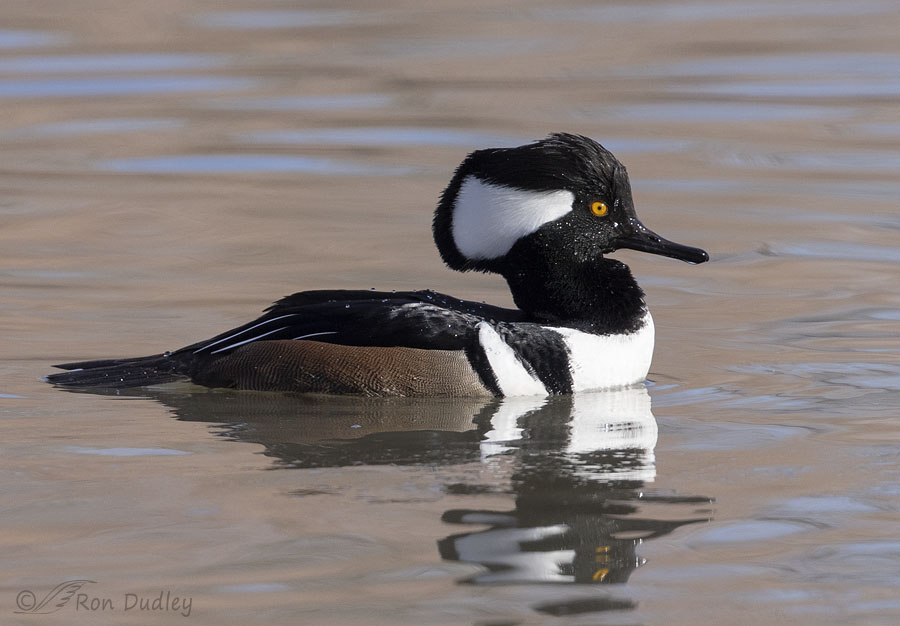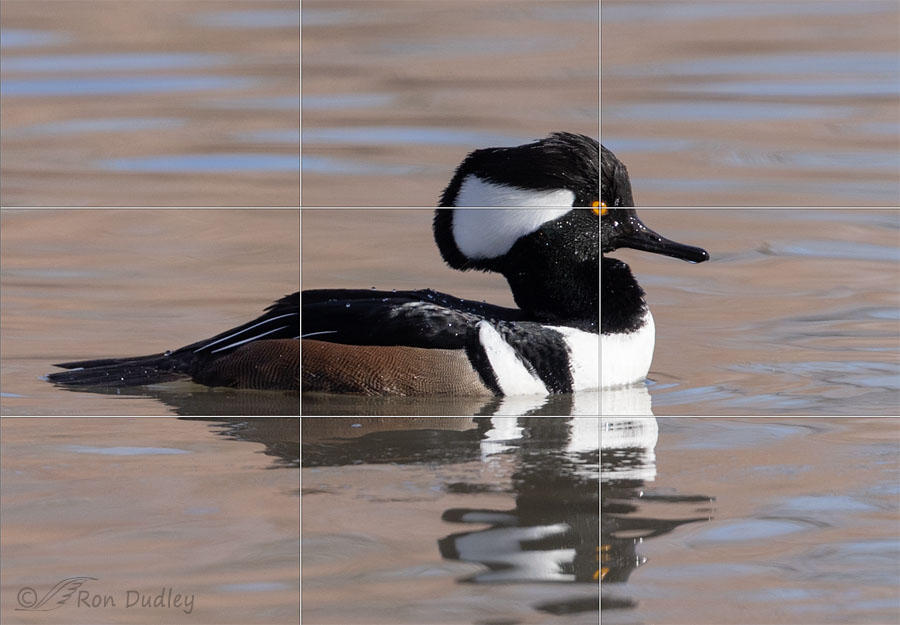A handsome bird and a couple of photo processing tips.

This photo of a male Hooded Merganser, taken two days ago, isn’t one I’d normally post to my blog. I like it reasonably well but I’m not a big fan of the pose, which for my tastes is a little too stiff and formal. I’d like it better if the bird’s head was turned more toward me or he was doing something interesting.
But while I was playing with the photo in Photoshop I noticed something about it that I found interesting and quite unusual. The “rule of thirds” actually worked with it. When I placed the merganser to my liking within the frame I’d chosen, the bird’s eye, the most important element of the photo, was…

positioned exactly according to the rule of thirds. For me that very rarely happens, especially with birds.
“The Rule of Thirds is a type of off-center composition where important elements of a photograph are placed along a 3×3 grid, which equally divides the image into nine parts. For many photographers, this type of composition is a basic way to give structure to photographs and make them more appealing.”
The rule of thirds isn’t really a rule – it’s more of a guideline. When it can be followed, many viewers find the off-center composition to be more interesting and aesthetically pleasing. But I rarely follow it deliberately, other than to avoid centering my subject and/or its most important element – often the eye of the bird. I find that the body shape of a typical bird, when the bird is close to frame-filling, doesn’t naturally conform to the rule of thirds. And attempting to force the bird to conform when I’m cropping isn’t usually worth the effort. I typically lose more than I gain.
But when the rule of thirds does work with one of my photos it gets my attention, in part because it so rarely happens. Which is one of the reasons I’m featuring this photo in today’s post.
While I’m at it I thought I’d point something else out about this image.
One of the challenges of photography is rotating your photos to level while you’re processing them. For me, not many things can ruin an otherwise interesting photo more quickly than having it be obviously tilted. I can’t get past the tilt. But it isn’t always easy to determine when an image is level during processing because many photos don’t provide obvious leveling cues, such as a horizon in the background or plants that you know are growing vertically.
But when a bird is in water, the bird’s reflection typically provides all the cues you need.
If the water in front of the bird, where the reflection is, is calm (or relatively so), a perfectly vertical line drawn between some element of the actual bird and the reflection of that same element, means that the photo is level. If the vertical line doesn’t connect those two chosen elements, all you have to do during processing is rotate the photo until they are connected. Then the image is level. It’s a matter of physics.
Prior to processing, the photo above had a significant and annoying counterclockwise tilt that drove me more than a little nuts. So I rotated it clockwise until the vertical line on the right passed through both the bird’s eye and the reflection of the eye, as seen in the second photo above. Then the photo was level.
OK, I’ve rattled on more than long enough. Apologies to my bird photography friends who already know all this stuff.
Ron


Beautiful photo, Ron. And interesting info about the rule of thirds and leveling. Condolences to Beth for dropping her camera! It gives me the shivers especially since I have also come quite close to dropping my little Canon.
Thanks, Melanie. Hang on to your camera!
Wow! Thanks for the tip about leveling and reflections! I just got a new Nikon P 1000 ( after dropping the first one down to the cement basement floor) and am raring to go photographing. So I shall try this! Love your photos and teachings
“after dropping the first one down to the cement basement floor”
Ouch! Thankfully I’ve never dropped any of my cameras or lenses. But a couple of times I came very, very close.
Great lesson in composition and leveling. I haven’t used the waterline reflection for leveling in that fashion before. Always happy to have new tools!
Thank you, Brett.
Thank you teacher. And thanks for this beautiful illustration of the lesson too.
You’re very welcome, EC.
For your bird photographer friends, your post may be just a review, but for your non-photographer friends, there’s a lot of good stuff here. Because you are teaching us how to SEE and assess a photograph, and that is so valuable. Being only an observer of photographs, it is helpful to have some knowledge of what goes into making them. It’s nice to know about the “Rule of Thirds” or levelling by lining up the eye and it’s reflection. The next time I look at a photo that makes me uncomfortable for some reason, maybe now I have some extra tools to try and figure out why. Thanks!
“The next time I look at a photo that makes me uncomfortable for some reason, maybe now I have some extra tools to try and figure out why.”
I love that thought, Carolyn.
Sensational shot!
Charlotte Norton
Thanks, Charlotte.
Wish I had had you for a high school teacher! Excellent examples and clarifying text, plus a beautiful portrait of a handsome drake. Thanks.
Thanks very much, Burrdoo. That means a lot.
‘I guess my off-kilter body shape matches my personality …’

 Lucky for us Ron!
Lucky for us Ron!
I’m glad you think so, Kathleen. I suspect not everyone does…
Interesting! Very aware of the rule of 3rds and how they sometimes don’t work well……. Using the reflection along with the bird to determine level is new to me – VERY useful tool when available methinks.
Using the reflection along with the bird to determine level is new to me – VERY useful tool when available methinks. 
Methinks too, Judy. Thank you.
Ron, I absolutely loved this post! I follow you because I learn so much from you and this is a great example. The vertical line between the eyes was an “aha moment” for me. Thank you.
“The vertical line between the eyes was an “aha moment” for me.”
Excellent, Kellie. Teachers, even retired teachers, love aha moments.
First of all, I think it is a stunning photo. The only thing I see as wanting is a bit more sunlight would have been nice on the white of the head.
Composition is an often overlooked element by most casual photographers. For me, one of my favorite parts of shooting and editing is composition. So I really appreciate your detailed narrative. I had never thought of using the reflection in the water to level the photo. Great tip! Thanks.
“I had never thought of using the reflection in the water to level the photo.”
Michael, with birds in water the reflection is often the ONLY cue you have to determine level. It’s a tip I first learned many years ago on a bird photography critique forum (Nature Photographer’s Network) and it has served me well countless times over the years.
Beautiful photo and excellent information. I often ignore the rule of thirds if I think the photo is more attractive being outside the rule, but for the most part I try to stay with it. About 20 years ago now I crashed my mountain bike into a wall and broke my collarbone. Ever since my right side droops lower that my left. For photos the result is that all photos I take if not corrected, also droop to the right.
“my right side droops lower that my left”
That’s something else we have in common, Everett. I threw javelin competitively for five years while I was in high school and college and overdeveloped my right side and arm compared to my left. As a result, my right shoulder droops significantly and noticeably lower than my left.
I guess my off-kilter body shape matches my personality….